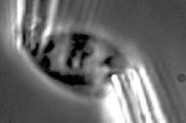Why you should care about nuclear mechanics and morphology - Abnormal nuclear morphology has been associated with human disease since the development of microscopes that could image the nucleus of the cell (late 1800s). Abnormal nuclear morphology has been used for nearly a century as a diagnostic marker of human diseases. An example of this is the Pap smear developed in the 1930s to diagnose cervical cancer. Abnormal nuclear morphology has been reported across the human disease spectrum including: aging, heart disease, muscular dystrophy, atherosclerosis, diabetes, neuronal disorders, and cancer (breast, cervical, lung, prostate, renal, leukemia). However, we still do not understand the the basis of nucleus maintains its shape and the consequences of shape loss. THE SIMPLE ANSWER : Mechanics (physical strength) determines the ability to maintain shape and compartmentalization, which controls major nuclear functions.
Cell Nuclear Mechanics - The Stephens Lab has developed a novel micromanipulation approach to isolate and measure the force response of a single mammalian nucleus from a living cell. Using this technique, we have provided for the first time, that ability to distinguish the separate roles of the two major mechanical component of the nucleus, chromatin and lamins. Specifically, micromanipulation force measurements provide the observation of a two-regime force response dictated by chromatin for short strains and lamin A at long strains via strain stiffening (Stephens et al., 2017 MBoC). This work revealing novel findings of the separate roles of chromatin and lamins in nuclear mechanics and the critical contribution of our complementary force measurement technique is summarized in a mini-review (Stephens et al., Nucleus 2017).
Video/technique – A single nucleus is isolated from a living cell and suspended between two micropipettes. The right “pull” micropipette extends the whole nucleus while the deflection of the left “force” micropipette measures force. The force is calculated by the “force” micropipette’s deflection distance multiplied by the pre-measured spring constant. At the end of the video, the chromatin within the nucleus is condensed by spraying 10 mM MgCl2 via a third micropipette that is out of view. Chromatin condensation causes nucleus to contract, and the “force” micropipette is further deflected meaning the stiffness of the nucleus increased.
Cell Nuclear Morphology - The mechanical contribution of chromatin also affects nuclear shape/morphology as decreased/increased chromatin-based nuclear mechanics induces/rescues nuclear blebbing, respectively, independent of lamin levels (Stephens et al., 2018 MBoC). Abnormal nuclear morphology results in nuclear ruptures that cause cellular dysfunction, including DNA damage, altered transcription, and cell cycle disruption. This dysfunction could possibly be the basis for dysfuction in human diseases presenting abnormal nuclear morphology (Stephens et al., 2019 Curr Opin Cell Bio). Further we find that a native mechanosensitive response of the cell can be used to rescue nulcear mechanics, morphology, and function through chromatin-based rigidity (Stephens et al., 2019 MBoC). Our work continues investigations aimed at uncovering the mechanical basis of nuclear shape and the functional consequences of loss of nuclear shape and compartmentalization.
Video – Human HT1080 cells treated with histone deacetylase inhibitor (HDACi) VPA, to decompact chromatin and weaken the nucleus, exhibit nuclear blebbing and rupture. Nuclear rupture is tracked by NLS-GFP, which leaves the nucleus upon rupture, but does reacculmulate upon healing. Nuclear shape is tracked by H2B-RFP (magenta). We are working to understand if nuclear rupture which causes to cellular dysfunction is part of human disease.
